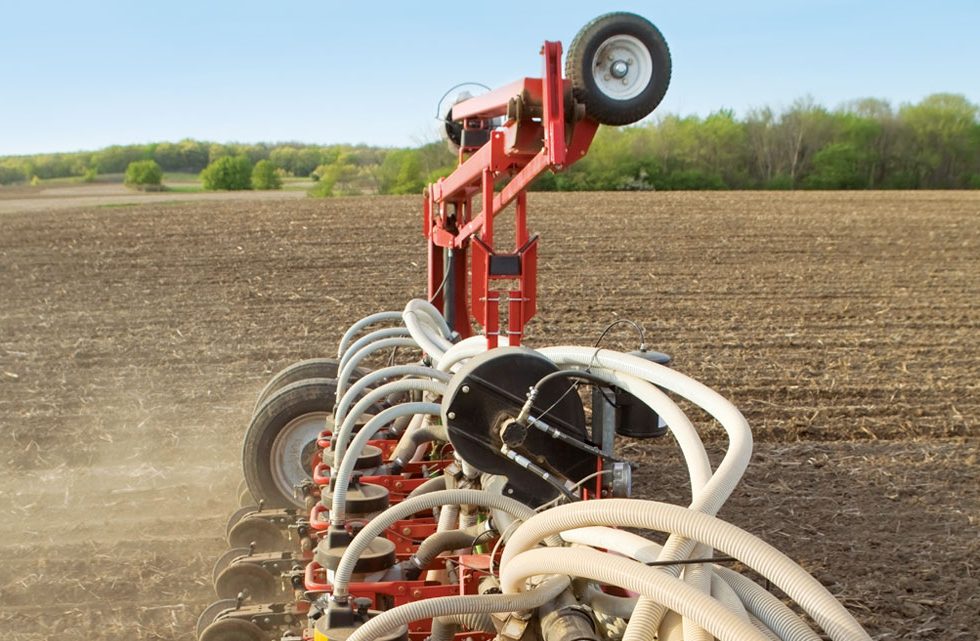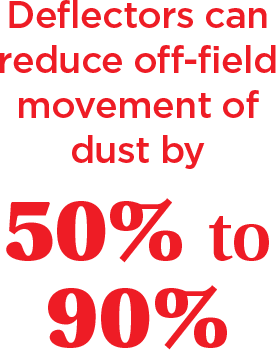New research shows that the use of deflectors on planters helps to reduce pollinator exposure to dust from treated seed.
With the goal of protecting pollinators from seed treatment dust during planting, seed companies and farmers are interested in knowing if deflectors reduce pollinator exposure to dust and which ones work best with the least amount of hassle.
While parts of Europe mandate the use of deflectors to reduce dust, more research is needed in North America. Deflectors need to be tested for their impact on planter performance, as well as efficacy in reducing dust concerns.
In the European Union, the deflector is positioned at the output of the planter turbine (for negative pressure planters) and intended to project dust released during planting toward the ground to reduce off-field drift.
A study done in Italy, called the APENET project, looked at the dispersal of seed treatment dust using a precision pneumatic planter equipped with deflectors. Two prototype deflectors were used to test drift reduction.
In the European Food Safety Authority’s 2012 evaluation of the study, it reported that a detailed analysis of the results could not be performed; however, general trends could be observed. EFSA reports: “In particular, the dust and therefore the deposition of residues in the off-crop area decreased with the distance; however, no decrease with the distance was apparent in the air concentration.”
“Deflectors have been shown to work in other countries to reduce the risk of dust exposure during planting of treated seeds …”
— Henry VanAnkum
According to the report, when using the deflectors, the reduction in dust that had settled on top of the soil for imidacloprid ranged from 89 percent to 95.4 percent. The overall reduction for the other active substances for was 74.4 percent for clothianidin, 88.6 percent for thiamethoxam and 94.8 percent for fipronil.
EFSA reported that reductions in air concentration of imidacloprid ranged from 53 to 72 percent for the two prototypes. The reduction in air concentration was 86 percent for clothianidin, 90 percent for thiamethoxam and 96 percent for fipronil.
Most recently, Syngenta launched its own research project looking a various deflector kits that farmers can use to retrofit planters. According Syngenta’s three-year trial in Europe, the percentage of active ingredient that was applied to the seed, which ended up on the soil, was higher for planters without deflectors.
For instance, when the dust levels were measured 5 meters from the planters, the soil around the planter with the deflector kit had a mean of less than 0.1 percent, while the soil near the planter without a deflector had a mean of about 0.8 percent. However, that gap narrows the further away from the planter measurements are taken.
Chris Davison, Syngenta Canada head of corporate affairs, reports that testing in the European Union and North America by Syngenta and other stakeholders demonstrates a 50 to 90 percent reduction in off-field movement of dust. And, Davison says, that deflectors are confirmed by EU monitoring programs to reduce the number of bee incidents.
Bayer CropScience also promotes solutions for controlling dust. One such solution is an air-cleaning technology for drillers known as SweepAir. Marc Andrieux, Bayer head of SeedGrowth Technology and Services and Seed Growth Coatings, says that this system separates dust from the air, with any captured dust being diverted into the ground along with any active ingredient. First field tests with the prototype in Europe indicate dust reduction levels of more than 95 percent.
Back on this side of the Atlantic, Ontario Ministry of Agriculture, Food and Rural Affairs, Grain Farmers of Ontario and Syngenta are working with Ontario farmers on a pilot project to test deflectors and how they affect dust drift. Researchers are looking at planter performance (air speed, pressure, noise and buildup of Fluency Agent — mandated for use in Canada) and plant stand.
This past growing season was the first year for the pilot project and nearly 30 growers from south-western Ontario signed up to participate in the project.
“Protecting pollinators and providing farmer members with tools to reduce the risk of dust exposure is a priority,” says Henry VanAnkum, Grain Farmers of Ontario chair. “Deflectors have been shown to work in other countries to reduce the risk of dust exposure during planting of treated seeds and this project will provide us with firsthand accounts from our farmers on their experience.”
As part of the pilot project, Syngenta provided the equipment and growers installed commercial and after-market units. Afterwards, project participants were asked to complete a survey. To date, Davison says growers are reporting that it takes about two to four hours to install the deflector kits with some customizing needed, a reduction in fan noise, minimal buildup of Fluency Agent, negligible to no impact on pressure and no obvious impact on plant stand. Official survey results should soon be available.












